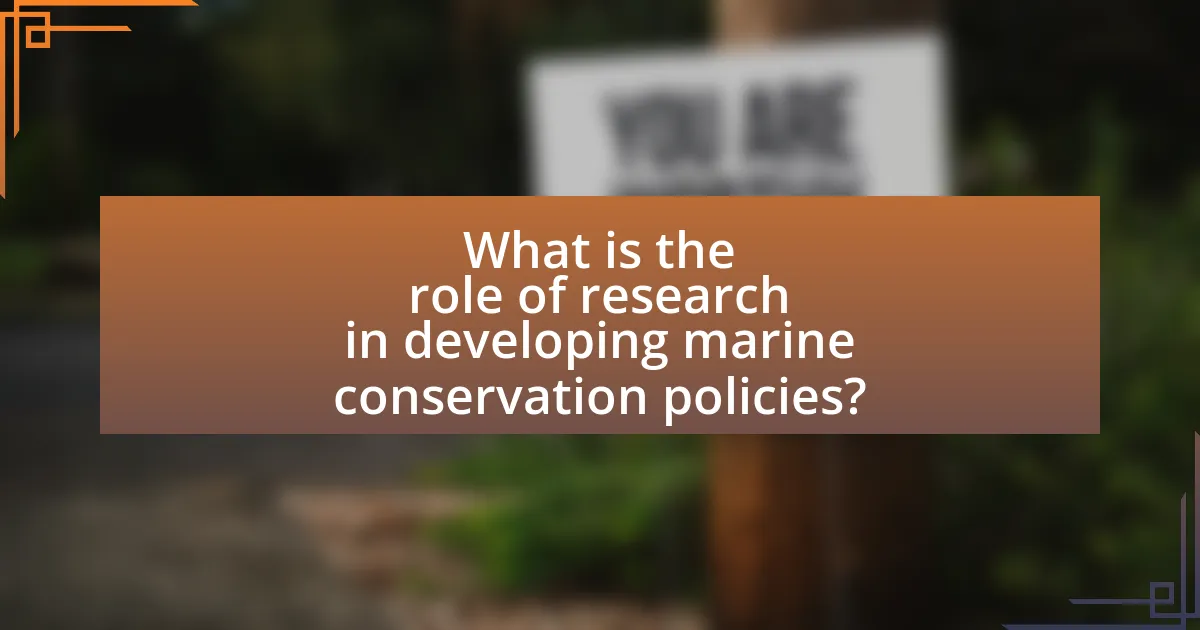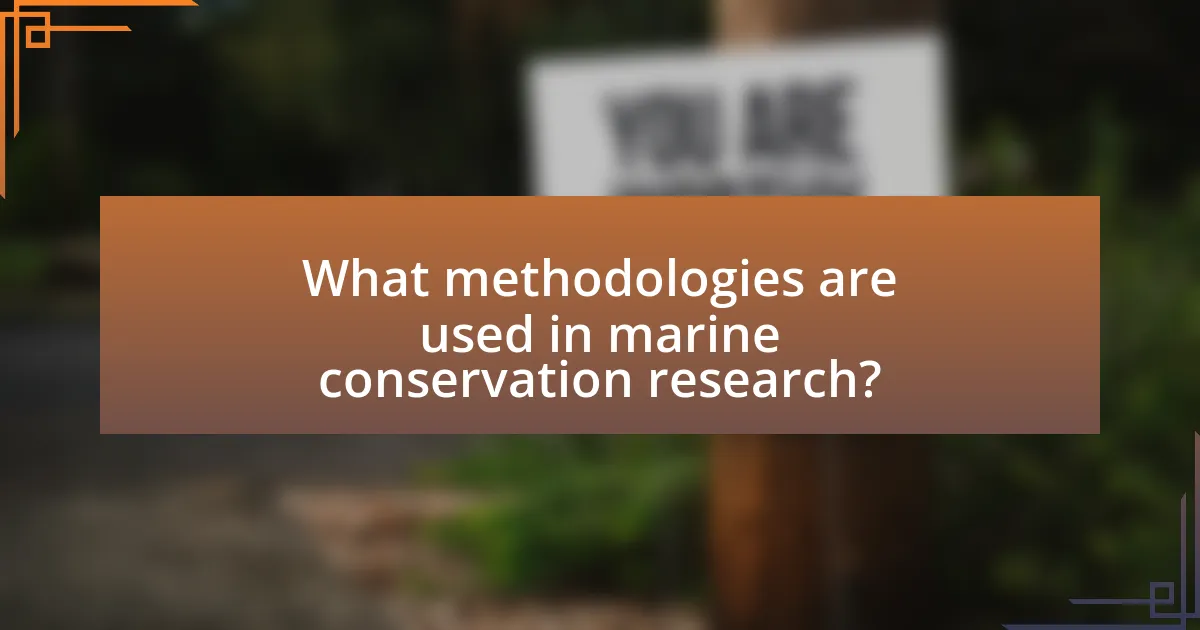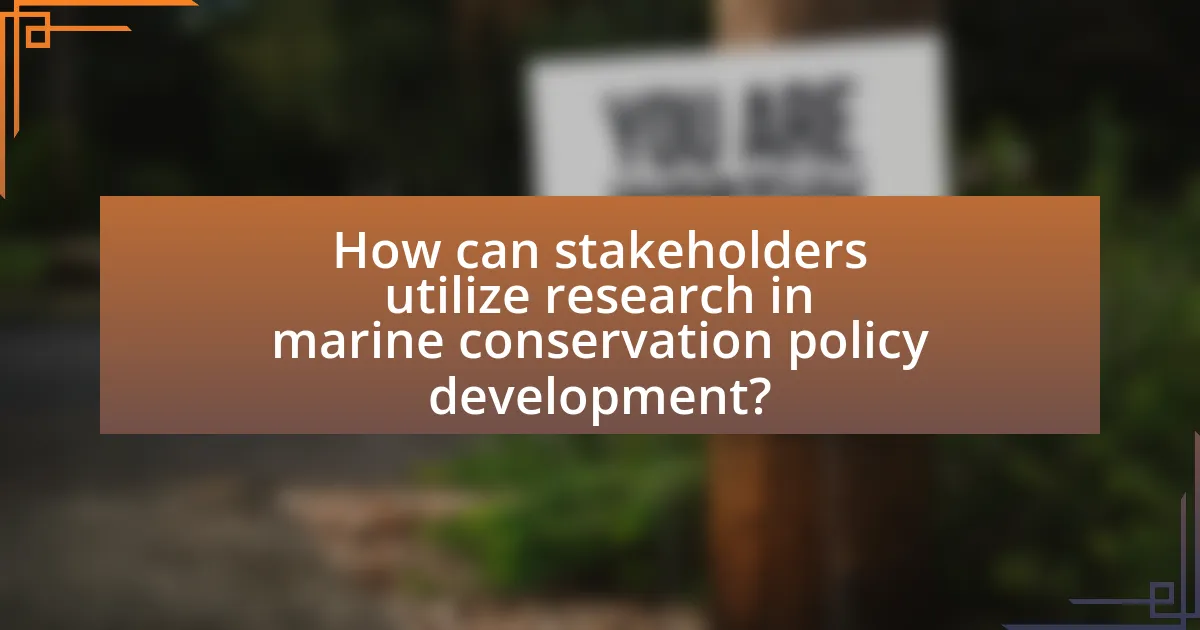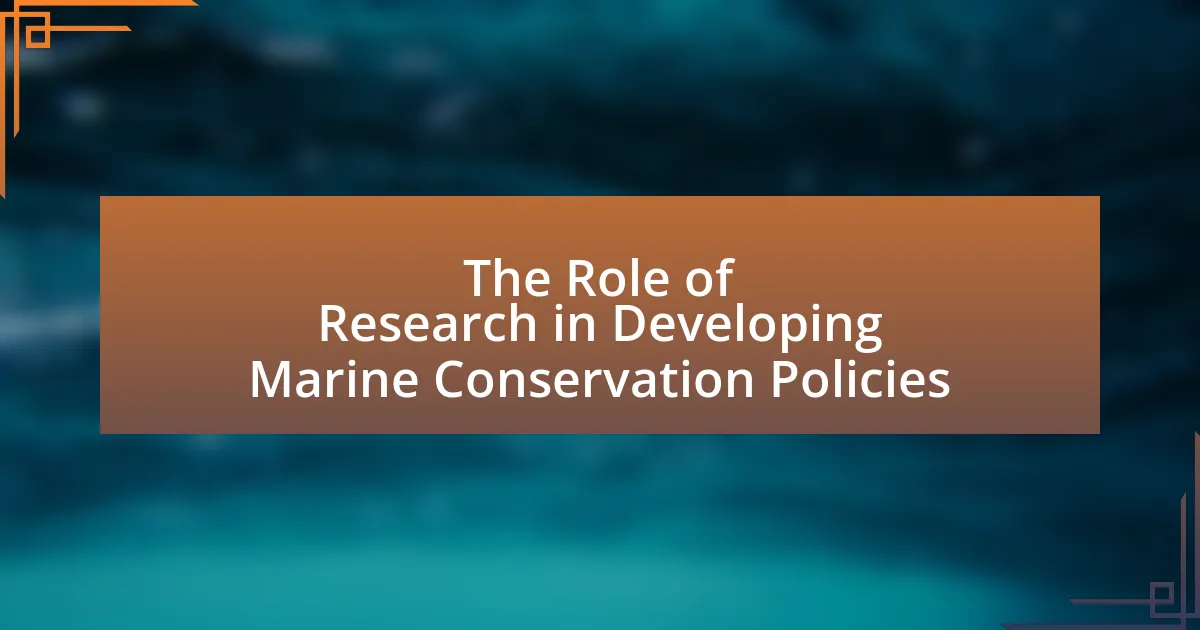Research is fundamental in developing marine conservation policies, providing essential scientific data that informs policymakers about marine ecosystems and the effects of human activities. The article outlines how research guides decision-making by revealing insights into species dynamics, habitat conditions, and the effectiveness of conservation measures. It emphasizes the importance of various research methodologies, including ecological studies and stakeholder engagement, in formulating effective policies. Additionally, the article discusses the consequences of lacking research in policy development and highlights the role of case studies in understanding successful conservation strategies. Overall, it underscores the necessity of integrating empirical evidence into marine conservation efforts to ensure sustainability and effectiveness.

What is the role of research in developing marine conservation policies?
Research plays a critical role in developing marine conservation policies by providing the scientific data and evidence necessary to understand marine ecosystems and the impacts of human activities. This data informs policymakers about the status of marine species, habitat conditions, and the effectiveness of existing conservation measures. For instance, studies such as the Global Ocean Commission’s report highlight the need for evidence-based approaches to address issues like overfishing and habitat degradation, demonstrating that informed policies can lead to improved marine biodiversity outcomes. Additionally, research facilitates stakeholder engagement by identifying community needs and values, ensuring that policies are socially acceptable and effective.
How does research inform marine conservation policy decisions?
Research informs marine conservation policy decisions by providing evidence-based data that guides the formulation and implementation of effective strategies. For instance, studies on fish population dynamics and habitat degradation reveal critical insights into the health of marine ecosystems, which policymakers use to establish regulations such as fishing quotas and protected areas. A notable example is the research conducted by the National Oceanic and Atmospheric Administration (NOAA), which has demonstrated that marine protected areas can significantly enhance biodiversity and fish stocks, leading to more sustainable fisheries. This empirical evidence directly influences legislative frameworks and conservation initiatives, ensuring that policies are grounded in scientific understanding and aimed at preserving marine biodiversity.
What types of research are most relevant to marine conservation?
Ecological research is most relevant to marine conservation, as it provides essential data on species interactions, ecosystem dynamics, and habitat requirements. This type of research informs conservation strategies by identifying critical habitats and assessing the impacts of human activities on marine ecosystems. For instance, studies on coral reef ecosystems have shown that biodiversity loss can lead to decreased resilience against climate change, highlighting the need for targeted conservation efforts. Additionally, fisheries research is crucial, as it helps in understanding fish population dynamics and sustainable harvesting practices, which are vital for maintaining fish stocks and ecosystem health.
How do research findings influence policy formulation?
Research findings significantly influence policy formulation by providing evidence-based insights that guide decision-making processes. Policymakers rely on empirical data and analyses from research to identify issues, assess potential solutions, and evaluate the effectiveness of existing policies. For instance, studies on marine biodiversity loss have led to the implementation of protective regulations, such as the establishment of marine protected areas, which are informed by scientific assessments of ecosystem health and species populations. This reliance on research ensures that policies are not only relevant but also effective in addressing specific environmental challenges, as demonstrated by the success of the Marine Conservation Society’s initiatives, which are grounded in rigorous scientific research.
Why is research essential for effective marine conservation?
Research is essential for effective marine conservation because it provides the scientific data necessary to understand marine ecosystems and the impacts of human activities. This understanding enables policymakers to develop targeted conservation strategies that address specific threats, such as overfishing and habitat destruction. For instance, studies have shown that marine protected areas can significantly enhance biodiversity and fish populations, as evidenced by a 2015 analysis published in the journal “Nature,” which found that well-managed marine reserves can lead to a 446% increase in fish biomass. Thus, research informs evidence-based decision-making, ensuring that conservation efforts are both effective and sustainable.
What are the consequences of lacking research in policy development?
Lacking research in policy development leads to ineffective and potentially harmful policies. Without empirical data and analysis, policymakers may rely on assumptions or anecdotal evidence, resulting in decisions that do not address the actual needs or challenges of the marine environment. For instance, a study by the National Oceanic and Atmospheric Administration (NOAA) highlights that policies based on insufficient research can lead to overfishing, habitat destruction, and loss of biodiversity, ultimately undermining conservation efforts. Additionally, the absence of rigorous research can foster public distrust in policy decisions, as stakeholders may perceive them as arbitrary or uninformed.
How does research contribute to understanding marine ecosystems?
Research significantly enhances the understanding of marine ecosystems by providing empirical data and insights into species interactions, habitat dynamics, and environmental changes. For instance, studies on coral reef ecosystems reveal how temperature fluctuations affect biodiversity and resilience, as documented in the research by Hughes et al. (2017) in “Nature,” which found that rising sea temperatures lead to widespread coral bleaching, impacting marine life. Additionally, research on nutrient cycling in coastal areas helps identify the effects of pollution on ecosystem health, as shown in the work of Nixon (1995) in “Estuaries,” which highlighted the relationship between nutrient loading and algal blooms. Such findings are crucial for informing conservation policies aimed at protecting marine biodiversity and ensuring sustainable management of ocean resources.

What methodologies are used in marine conservation research?
Marine conservation research employs various methodologies, including field surveys, remote sensing, modeling, and stakeholder engagement. Field surveys involve direct observation and data collection in marine environments, allowing researchers to assess biodiversity and ecosystem health. Remote sensing utilizes satellite imagery and aerial surveys to monitor large-scale environmental changes and habitat conditions. Modeling techniques, such as ecological modeling and simulation, help predict the impacts of human activities on marine ecosystems. Stakeholder engagement involves collaboration with local communities, policymakers, and scientists to incorporate diverse perspectives and knowledge into conservation strategies. These methodologies collectively enhance the understanding of marine ecosystems and inform effective conservation policies.
How do qualitative and quantitative methods differ in marine research?
Qualitative and quantitative methods differ in marine research primarily in their approach to data collection and analysis. Qualitative methods focus on understanding human experiences, perceptions, and behaviors related to marine environments through interviews, focus groups, and observations, allowing researchers to gather in-depth insights into community values and attitudes towards conservation. In contrast, quantitative methods emphasize numerical data and statistical analysis, utilizing surveys, experiments, and ecological measurements to quantify variables such as fish populations, water quality, and habitat conditions, enabling researchers to identify patterns and make generalizable conclusions. For instance, a study published in “Marine Policy” by Charles et al. (2018) illustrates how qualitative interviews revealed local fishermen’s knowledge about declining fish stocks, while quantitative surveys provided statistical evidence of population declines, demonstrating the complementary roles of both methods in informing marine conservation policies.
What are the strengths and weaknesses of qualitative research in marine conservation?
Qualitative research in marine conservation has strengths such as providing in-depth insights into human behaviors, perceptions, and cultural contexts that influence marine ecosystems. This approach allows researchers to explore complex social dynamics and stakeholder perspectives, which are crucial for effective conservation strategies. For instance, qualitative methods like interviews and focus groups can reveal local knowledge and values that quantitative data might overlook.
However, qualitative research also has weaknesses, including limited generalizability due to small sample sizes and potential researcher bias in data interpretation. The subjective nature of qualitative analysis can lead to challenges in replicability and may not provide the statistical rigor needed for broader policy applications. For example, findings from a qualitative study in a specific community may not be applicable to other regions, limiting the overall impact on marine conservation policies.
How can quantitative data enhance marine conservation policies?
Quantitative data enhances marine conservation policies by providing measurable evidence that informs decision-making and prioritizes resource allocation. For instance, data on fish populations, habitat conditions, and biodiversity indices allows policymakers to identify critical areas for protection and assess the effectiveness of existing regulations. A study published in “Conservation Biology” by McCauley et al. (2015) demonstrated that regions with robust quantitative assessments of marine resources saw a 30% increase in compliance with conservation measures. This data-driven approach ensures that policies are based on empirical evidence, leading to more effective and targeted conservation strategies.
What role do case studies play in marine conservation research?
Case studies play a critical role in marine conservation research by providing detailed, context-specific insights into the effectiveness of conservation strategies. They allow researchers to analyze real-world applications of policies and practices, facilitating a deeper understanding of ecological dynamics and human interactions within marine environments. For instance, a case study on the recovery of the California sea otter population illustrates how targeted conservation efforts, such as habitat protection and legal regulations, can lead to significant ecological recovery. This specific example demonstrates that empirical evidence from case studies can inform policy decisions, enhance stakeholder engagement, and guide future conservation initiatives.
How can case studies provide insights into successful conservation strategies?
Case studies can provide insights into successful conservation strategies by offering detailed, real-world examples of how specific approaches have been implemented and their outcomes. For instance, the case study of the Great Barrier Reef Marine Park demonstrates how integrated management strategies, including zoning and stakeholder engagement, have led to improved biodiversity and ecosystem health. This case illustrates the effectiveness of adaptive management practices, which are informed by ongoing research and monitoring, thereby reinforcing the importance of evidence-based decision-making in conservation efforts.
What lessons can be learned from failed marine conservation efforts?
Failed marine conservation efforts highlight the importance of adaptive management and stakeholder engagement. These failures often stem from a lack of scientific data, insufficient community involvement, and failure to consider socio-economic factors. For instance, the collapse of the Newfoundland cod fishery in the early 1990s resulted from overfishing and inadequate regulatory measures, demonstrating the need for robust data collection and analysis to inform policies. Additionally, the failure of the Marine Protected Areas in the Caribbean illustrates that without local community support and involvement, conservation initiatives are likely to falter. These examples underscore that successful marine conservation requires a comprehensive approach that integrates scientific research, community engagement, and adaptive management strategies.

How can stakeholders utilize research in marine conservation policy development?
Stakeholders can utilize research in marine conservation policy development by integrating scientific findings into decision-making processes. This integration allows stakeholders to base policies on empirical evidence, ensuring that conservation efforts are effective and targeted. For instance, research studies, such as those published in the journal “Marine Policy,” demonstrate that data on fish populations and habitat health can inform regulations that protect biodiversity. By leveraging such research, stakeholders can identify critical areas for conservation, assess the impact of human activities, and develop adaptive management strategies that respond to changing environmental conditions.
What role do governments play in integrating research into policy?
Governments play a crucial role in integrating research into policy by facilitating the translation of scientific findings into actionable regulations and guidelines. They achieve this through funding research initiatives, establishing advisory committees, and promoting collaboration between researchers and policymakers. For instance, the U.S. National Oceanic and Atmospheric Administration (NOAA) actively incorporates scientific research into marine policy decisions, ensuring that conservation measures are based on the latest scientific evidence. This integration is essential for effective marine conservation, as it allows for adaptive management strategies that respond to new data and changing environmental conditions.
How can NGOs leverage research to advocate for marine conservation?
NGOs can leverage research to advocate for marine conservation by utilizing scientific data to inform policy decisions and raise public awareness. By conducting or commissioning studies that highlight the ecological importance of marine environments, NGOs can present compelling evidence to policymakers, demonstrating the need for protective measures. For instance, research published in the journal “Marine Policy” shows that areas designated as marine protected areas (MPAs) can lead to a 20% increase in fish populations, underscoring the effectiveness of conservation strategies. Additionally, NGOs can use research findings to engage communities and stakeholders, fostering a collaborative approach to conservation efforts. This evidence-based advocacy not only strengthens the credibility of NGOs but also enhances their ability to influence legislation and secure funding for marine conservation initiatives.
What partnerships are essential for effective research collaboration?
Effective research collaboration in marine conservation policies requires partnerships among academic institutions, governmental agencies, non-governmental organizations (NGOs), and local communities. Academic institutions provide scientific expertise and research methodologies, while governmental agencies offer regulatory frameworks and funding. NGOs contribute grassroots knowledge and advocacy, and local communities ensure that research is relevant to the socio-economic context. For instance, the collaboration between the University of California and the National Oceanic and Atmospheric Administration has led to significant advancements in marine ecosystem research, demonstrating the importance of these partnerships in achieving comprehensive conservation outcomes.
How can the public engage with marine conservation research?
The public can engage with marine conservation research by participating in citizen science projects, which allow individuals to contribute data and observations that support scientific studies. For example, initiatives like the Ocean Conservancy’s International Coastal Cleanup enable volunteers to collect data on marine debris, directly influencing research on pollution and its impacts on marine ecosystems. Additionally, public forums and workshops hosted by research institutions provide opportunities for community members to learn about ongoing studies and share their insights, fostering collaboration between scientists and the public. Engaging with social media campaigns and educational programs also helps raise awareness and encourages public involvement in marine conservation efforts.
What are the benefits of citizen science in marine research?
Citizen science significantly enhances marine research by increasing data collection efforts and fostering public engagement. This approach allows non-professionals to contribute valuable observations and data, which can lead to more comprehensive datasets. For instance, a study published in the journal “Frontiers in Marine Science” highlighted that citizen scientists contributed over 1.5 million records of marine species, aiding in biodiversity assessments and conservation planning. Furthermore, citizen science promotes awareness and education about marine ecosystems, encouraging community involvement in conservation efforts. This dual benefit of data enhancement and public engagement is crucial for developing effective marine conservation policies.
How can public awareness campaigns be informed by research findings?
Public awareness campaigns can be informed by research findings by utilizing data-driven insights to shape messaging and target audiences effectively. Research provides evidence on public perceptions, behaviors, and knowledge gaps regarding marine conservation, allowing campaign designers to tailor their strategies. For instance, studies such as “The Effectiveness of Marine Conservation Messaging” published in the Journal of Environmental Management demonstrate that campaigns grounded in scientific research significantly increase public engagement and support for conservation initiatives. By integrating these findings, campaigns can enhance their impact and foster greater community involvement in marine conservation efforts.
What best practices should be followed in marine conservation research?
Best practices in marine conservation research include employing a multidisciplinary approach, engaging local communities, utilizing robust data collection methods, and ensuring transparency in reporting findings. A multidisciplinary approach integrates biology, ecology, social sciences, and policy studies, which enhances the understanding of complex marine ecosystems. Engaging local communities fosters collaboration and ensures that conservation efforts are culturally relevant and supported by those directly affected. Utilizing robust data collection methods, such as remote sensing and long-term monitoring, provides reliable evidence for decision-making. Transparency in reporting findings builds trust among stakeholders and encourages informed policy development. These practices are supported by studies indicating that successful marine conservation initiatives often result from collaborative, data-driven, and community-involved efforts.
How can researchers ensure their work is relevant to policymakers?
Researchers can ensure their work is relevant to policymakers by actively engaging with them throughout the research process. This engagement includes identifying key policy questions, collaborating with policymakers to align research objectives with policy needs, and communicating findings in accessible formats. For instance, studies have shown that research initiatives that involve policymakers from the outset lead to more applicable outcomes, as seen in the collaborative efforts of the National Oceanic and Atmospheric Administration (NOAA) with marine scientists to inform fisheries management. By prioritizing these strategies, researchers can enhance the applicability and impact of their work on marine conservation policies.
What strategies can enhance the communication of research findings to stakeholders?
Effective strategies to enhance the communication of research findings to stakeholders include tailoring messages to the audience, utilizing visual aids, and engaging in interactive discussions. Tailoring messages ensures that complex research is presented in a way that resonates with stakeholders’ interests and knowledge levels, thereby increasing comprehension and relevance. Utilizing visual aids, such as infographics and charts, can simplify data presentation, making it more accessible and memorable. Engaging stakeholders in interactive discussions fosters a two-way communication channel, allowing for feedback and clarification, which can lead to a deeper understanding of the research implications. These strategies are supported by studies indicating that effective communication significantly improves stakeholder engagement and decision-making in marine conservation efforts.
